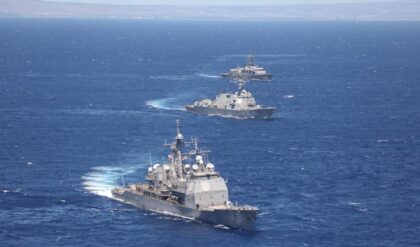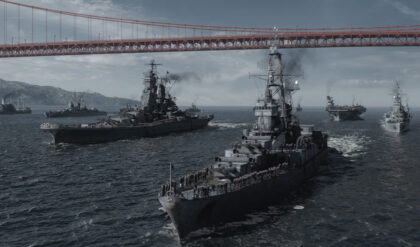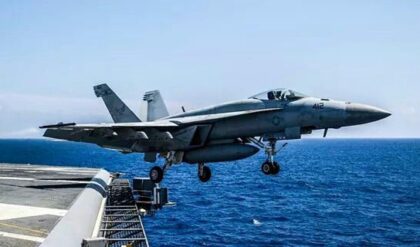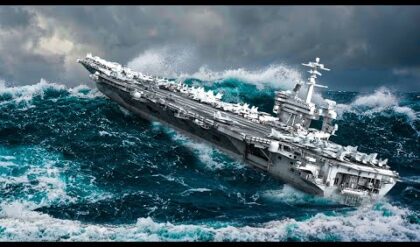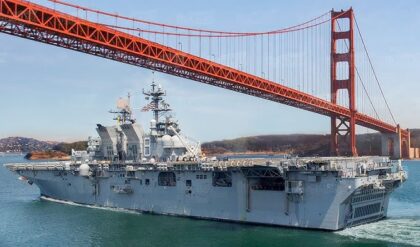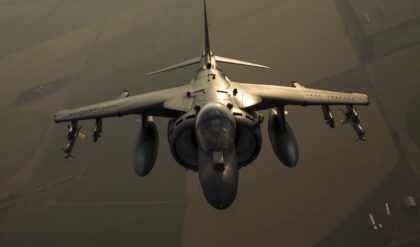The USS Enterprise: A Legendary Legacy in Naval History
While most people associate the name USS Enterprise with the iconic starship from Star Trek, this name holds a special place in the annals of US Navy history. The USS Enterprise, beyond its sci-fi connection, made its own mark as the first nuclear-powered aircraft carrier ever built, profoundly influencing the course of the Navy’s future.
Carrying the prestigious name “Enterprise,” it stands tall among the most celebrated names in naval history
. Designed as the flagship of a nuclear-powered task force capable of sustained operations without refueling, the USS Enterprise set a benchmark for all future US aircraft carriers, leaving an enduring legacy.

In August 1950, Admiral Forrest Sherman, the Chief of Naval Operations, initiated a feasibility study for nuclear-powered aircraft carriers.
As a test, a shore-based nuclear reactor known as the A1W reactor was constructed. Its success led to the approval of funds for a nuclear carrier in 1958.
The USS Enterprise was commissioned in November 1961, marking a historic milestone. It became the longest aircraft carrier ever constructed, measuring 1,123 feet in length and displacing 93,284 tons when fully loaded.
Powered by eight A2W reactors, a development of the A1W, the Enterprise boasted an astonishing 280,000 shaft horsepower, propelling its four propellers to speeds exceeding thirty-five knots. With a crew of 5,500, including the air wing, it could carry up to eighty-five aircraft.
The USS Enterprise shared its design with its conventionally powered predecessors, Kitty Hawk and Constellation. It featured four catapults, two on the bow and two on the port waist, as well as four aircraft elevators.
Its distinctively shaped superstructure earned the nickname “the beehive” and housed electronic countermeasures gear and SCANFAR, the world’s first shipboard phased-array radar consisting of the SPN-32 and SPN-33 search radars.
Interestingly, the USS Enterprise might have been the first unarmed aircraft carrier commissioned since the Navy’s inaugural carrier, USS Langley.
Originally intended to carry the Terrier surface-to-air missile, these armaments were omitted from the final design for cost control. It wasn’t until 1967 that two Mk. 25 Basic Point defense missile systems launchers were installed, each carrying eight Sea Sparrow Missiles.
These were later replaced with Mk. 29 launchers, and in the 1980s, three Mk. 15 Phalanx Close-In defense Systems were added to enhance the ship’s defenses.
Throughout its illustrious career, the USS Enterprise hosted a variety of famous carrier-borne aircraft, including F-4 Phantoms, F-14 Tomcats, A-1 Skyraiders, A-3 Skywarrior bombers, A-4 Skyhawks, A-5A Vigilantes, and A-7 Crusaders.
Originally designated as a Carrier, Attack, Nuclear (CVA(N)) ship, it was eventually redesignated as a multi-purpose CVN.
The final air wing to operate from the Enterprise was Carrier Air Wing One, which included four squadrons of F/A-18E/F Super Hornets.
The operational history of the USS Enterprise commenced in 1962 when the ship participated in the Cuban Missile Crisis blockade.
In 1964, it embarked on Operation Sea Orbit, a remarkable feat where it, along with the nuclear-powered guided missile cruiser USS Long Beach and the nuclear-powered guided missile destroyer USS Bainbridge, collectively known as Task Force One, circumnavigated the globe in just sixty-five days, powered solely by nuclear energy.
This operation showcased the agility and rapid response capability of a nuclear-powered fleet to crises worldwide.

In 1965, the USS Enterprise initiated air operations off Vietnam, conducting airstrikes against Viet Cong and North Vietnamese targets.
In 1968, it served as the flagship for Task Force 71 during the response to the North Korean seizure of the spy ship USS Pueblo.
Later that year, it conducted additional airstrikes in Southeast Asia. The “Big E” would complete a total of six cruises off the coast of Vietnam, with the last one occurring in 1975.
In 1969, during readiness inspections off Hawaii, a rocket explosion on the flight deck resulted in a fire.
Twenty-eight crew members lost their lives, and 343 others were injured as nine bombs detonated in the blaze, destroying fifteen aircraft, including brand-new A-7 Corsairs.
Despite the devastating damage and casualties, the USS Enterprise demonstrated its resilience by being capable of emergency repairs and a swift return to air operations. However, it was sent to drydock in Hawaii instead.
The post-Vietnam era brought relative calm to the USS Enterprise until 1988 when its air wing sank an Iranian Saam-class frigate as part of Operation Praying Mantis, the US response to Iran’s mining of the Persian Gulf. During the 1990s, it enforced no-fly zones over Bosnia and Iraq.
In October 2001, it played a pivotal role in the initial air missions over Afghanistan, launching airstrikes against Taliban and Al-Qaeda forces.
On December 1, 2012, the USS Enterprise was deactivated, marking the beginning of its gradual preparation for disposal, including the removal of military equipment and the shutdown of its reactors.
The ship was formally decommissioned on February 3, 2017, in a private ceremony at the Newport News Shipyard in Virginia.
While the USS Enterprise undeniably validated the potential of nuclear power for aircraft carriers, its legacy extends far beyond this achievement.
It circumnavigated the globe three times, embarked on twenty-five overseas cruises, and recorded an astonishing four hundred thousand aircraft landings in its lifetime.
From combat missions in Vietnam to Afghanistan, it played a crucial role in countless operations. Tens of thousands, if not hundreds of thousands, of sailors proudly served as part of its crew over the years.
To ensure that the storied name of Enterprise lives on, the US Navy announced in 2012 that the third of the Gerald R. Ford-class carriers, CVN-80, would bear the name Enterprise well into the twenty-first century.

Video:
Hits: 198
